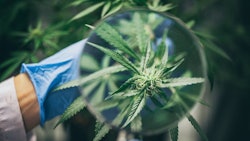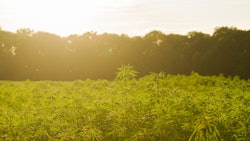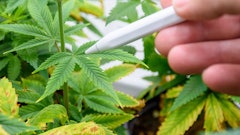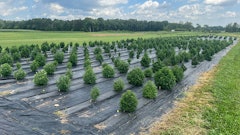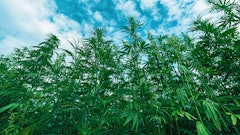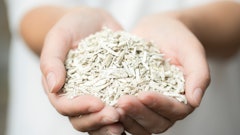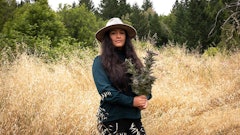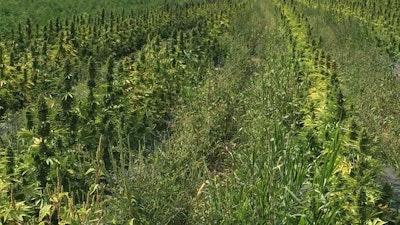
Cannabis ruderalis is considered a mutant variety and is native to Asia, Europe and Russia. These varieties have adapted to extreme environmental conditions, especially in colder regions of the world, complete life cycles in short periods and produce seeds in 70 to 80 days when compared to Cannabis sativa (120 days). Autoflowering cannabis varieties automatically switch from vegetative growth to the flowering stage with age, as opposed to the 12-hour dark and light cycles required with photoperiod-dependent strains.
According to research from Cornell University, autoflower hemp varieties have higher ratio of floral biomass and are able to thrive in tighter spacing. They also require lower fertilizer levels throughout the first 50 days of growth and CBD levels remain at 15% to 22%. Plant mature height can go up to 3 to 4 feet with a dominant single cola.
However, these plants are known to be sensitive to certain stress conditions, including transplanting stress. In order to optimize seed planting methods and minimize stress related yield reduction, experiments were conducted at Amos Zittel & Sons Greenhouse in Western New York as part of a New York state hemp research program. The goal was to determine the optimal growing time of several autoflower hemp varieties in plugs and subsequent transplanting in growing containers or to the field on plant growth and yield.
Experimental Methods
Feminized seeds of CBD varieties Sunbeam Haze and KG9201 and KG9202 from a California-based hemp breeding company were either planted directly in 3-gallon containers in custom soilless mix with added Mycorrhizea or in plugs (40 mL). Seeds germinated within three to four days at 94% germination rate. The seedlings from plugs were then transplanted into 3-gallon pots after eight,15, 22 and 29 days. The three autoflower seed varieties were also planted in a field.
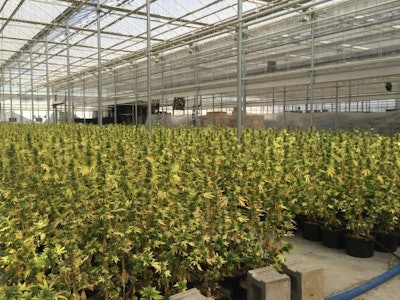
Some varieties that were part of the experiment were grown in a greenhouse with supplemental lighting. All photos courtesy of Sheila Bhattacharya
Plants were grown for 70 days in a controlled environment greenhouse with supplemental lighting from LEDs from June to August. Temperature was maintained at 82 to 85 degrees F during the day and 73 to 75 degrees F at night through a combination of heating, cooling and ventilation systems. Young cannabis plants in the vegetative stage were maintained at a relative humidity as high as 55% to 60%. As they reached the flowering stage when budding develops, humidity levels were reduced to 45%. The plants were irrigated and fertilized regularly using drip irrigation.
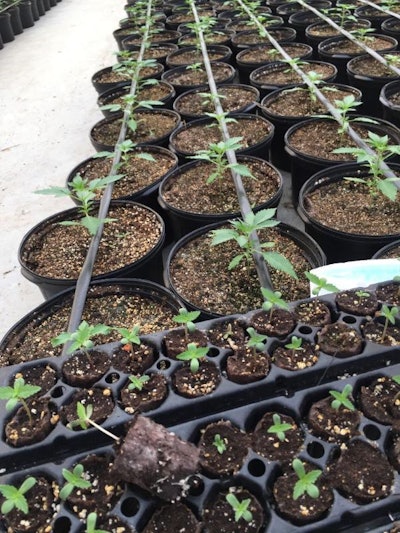
Growth measurements including plant height, canopy width and number of branches and buds were recorded at periodic intervals. The plants were harvested on day 35 (to compare vegetative growth) and day 70. Whole plant and bud yield data were also recorded; the harvest data on day 70 is presented later in this article.
We conducted another set of experiments with the three hemp varieties transplanted in the field.
In addition, most plants within the greenhouses were direct seeded in 3-gallon pots, harvested on day 70, air dried and shipped.
Results
The results demonstrated that growth was similar in seedlings transplanted from eight- and 15-day-old plugs compared with those directly planted in a 3-gallon container. Transplanting from plugs to a 3-gallon container after 22 days reduced plant height (Fig. 1) by at least 55% (both KG9201, 9202) and by 22% (Sunbeam) when compared to direct seeding. The total number of branches (Fig. 2) also significantly decreased when seedlings were transplanted after 22 days compared to plants from seeds directly planted in a 3-gallon container.
Fig. 1: Plant height of three autoflowering varieties at day 70.
Fig. 2: Number of branches on three autoflowering varieties at day 70.
While the number of buds was similar for Sunbeam Haze with any transplanting method, reduced bud count was observed in both KG9201, 9202 varieties when plugs were planted after 15 days or more. Bud dry weight, however, reduced significantly in all three varieties when transplanted from 15 days or more from plugs.
The bud dry weight (Fig. 4) per plant decreased by 31% and 68% when transplanted from plugs after 22 and 29 days, respectively, for Sunbeam when compared with direct seeding. However, bud dry weight dropped by 22% and 48% for KG9201 and by 16% and 41% for KG9202 when transplanted from plugs after 22 and 29 days, respectively. Experimental results at harvest (maturity) indicated that plant growth was reduced by 40% or more when plug seedlings were transplanted after 15 days or more to 3-gallon containers.
Reduction in plant growth (Fig. 2, 3, 4) and yield at 8 days in plugs may be due to low root mass development in plugs after 8 days, and its further root development with larger substrate volume. Optimal root development occurred at 15 days in plugs, and transplanting was successful.
Fig. 3: Number of buds of three autoflowering varieties day 70.
Fig. 4: Bud dry weight (with 8% moisture) of three autoflowering varieties at day 70.
Fig. 5: Total plant fresh weight of autoflowering varieties at day 70.
It is interesting to note that seedlings kept in plug liners for 28 days started flowering after 20 days. The stress on the tap root structure for prolonged period induced flower induction at seedling stage.
Direct seeding in 3-gallon containers produced the maximum number of flower buds with maximum plant height, plant width and produced the maximum number of branches.
Similar experiments were conducted in field planting with all three Hemp varieties and results were comparable to greenhouse studies. However, the overall plant biomass and bud yield in the field was, on average, 50% to 60% higher than in greenhouse-grown plants.
Conclusion
Direct seeding of Sunbeam Haze, KG9201 and KG9202 in 3-gallon containers produced the maximum number of flower buds with maximum plant height, width, and branches (overall plant yield). Results demonstrated that these autoflower hemp plants may be sensitive to transplant shock, and growers should consider transplanting to larger containers early in the plant’s lifecycle. And best results were observed when plants were transplanted from a liner to either the field or in larger containers within 15 days of seed planting. Based on these findings, direct seeding is recommended for maximum growth and yield.
Sheila Bhattacharya, Ph.D., is co-owner of Propagate Green and was greenhouse growing manager and technical adviser for Amos Zittel & Sons when the research was conducted. William Zittel contributed to this article. Acknowledgement: Kayagene provided seeds for research, and Evan and Kevin Zittel provided and managed all aspects of greenhouse and field operations.









